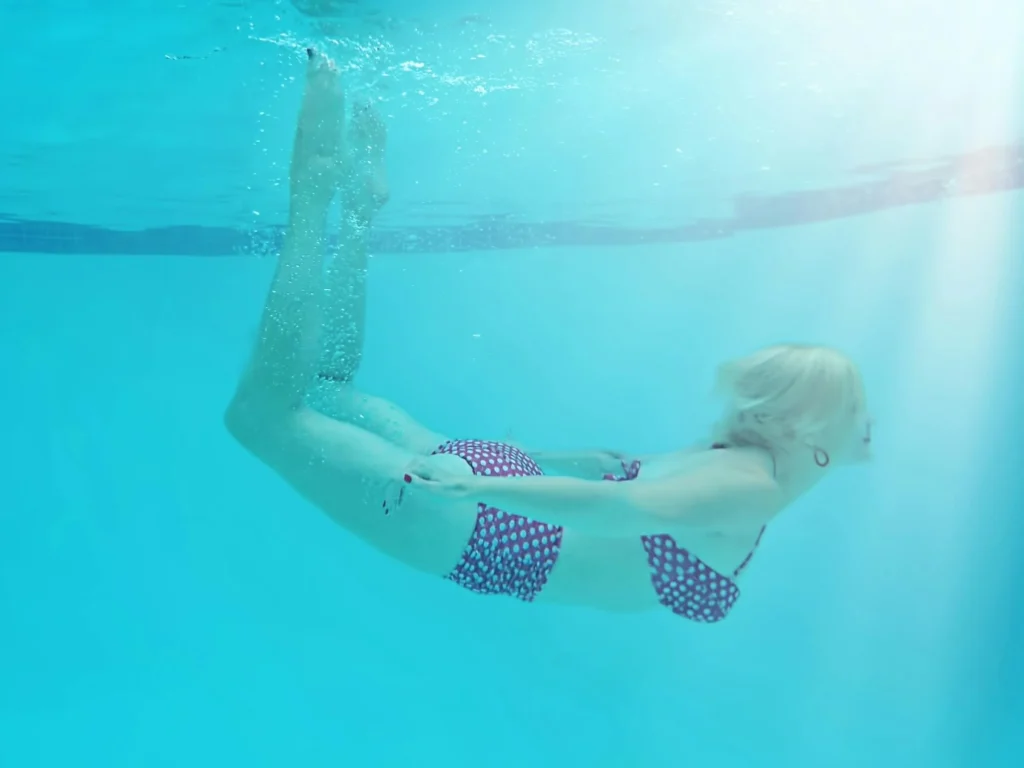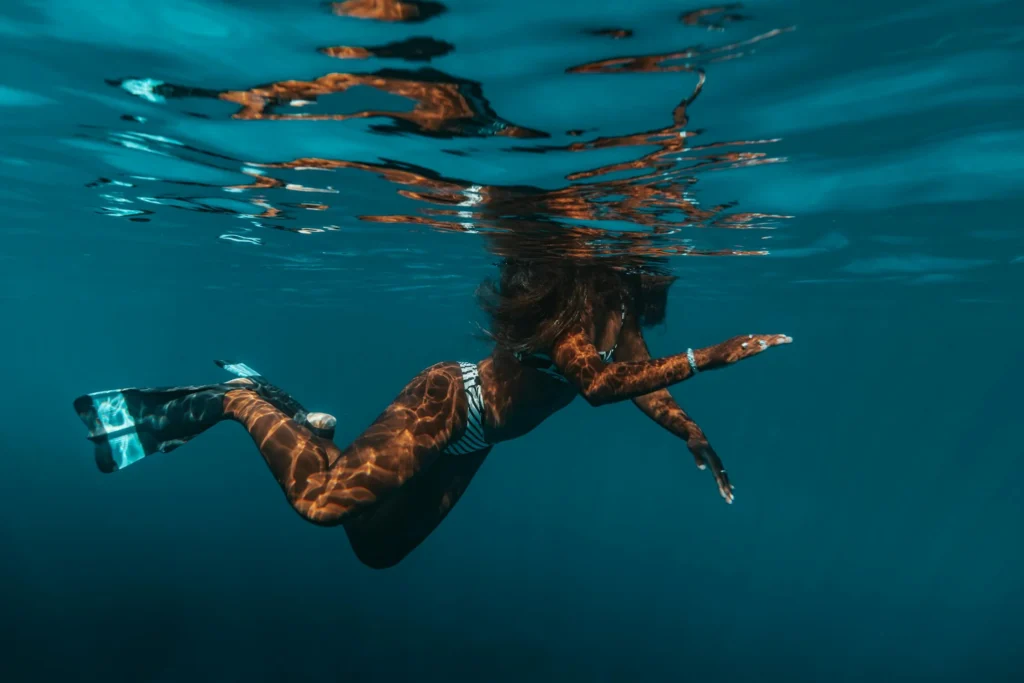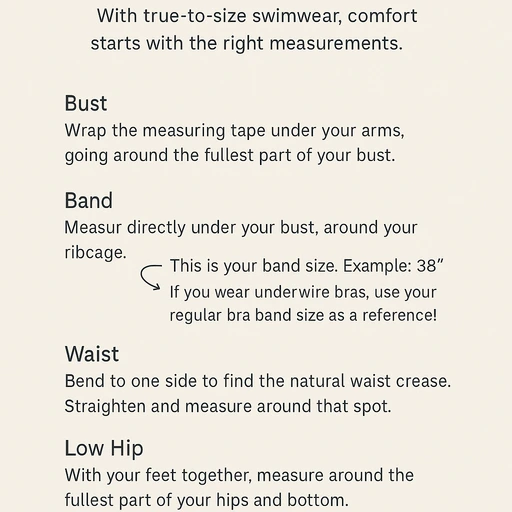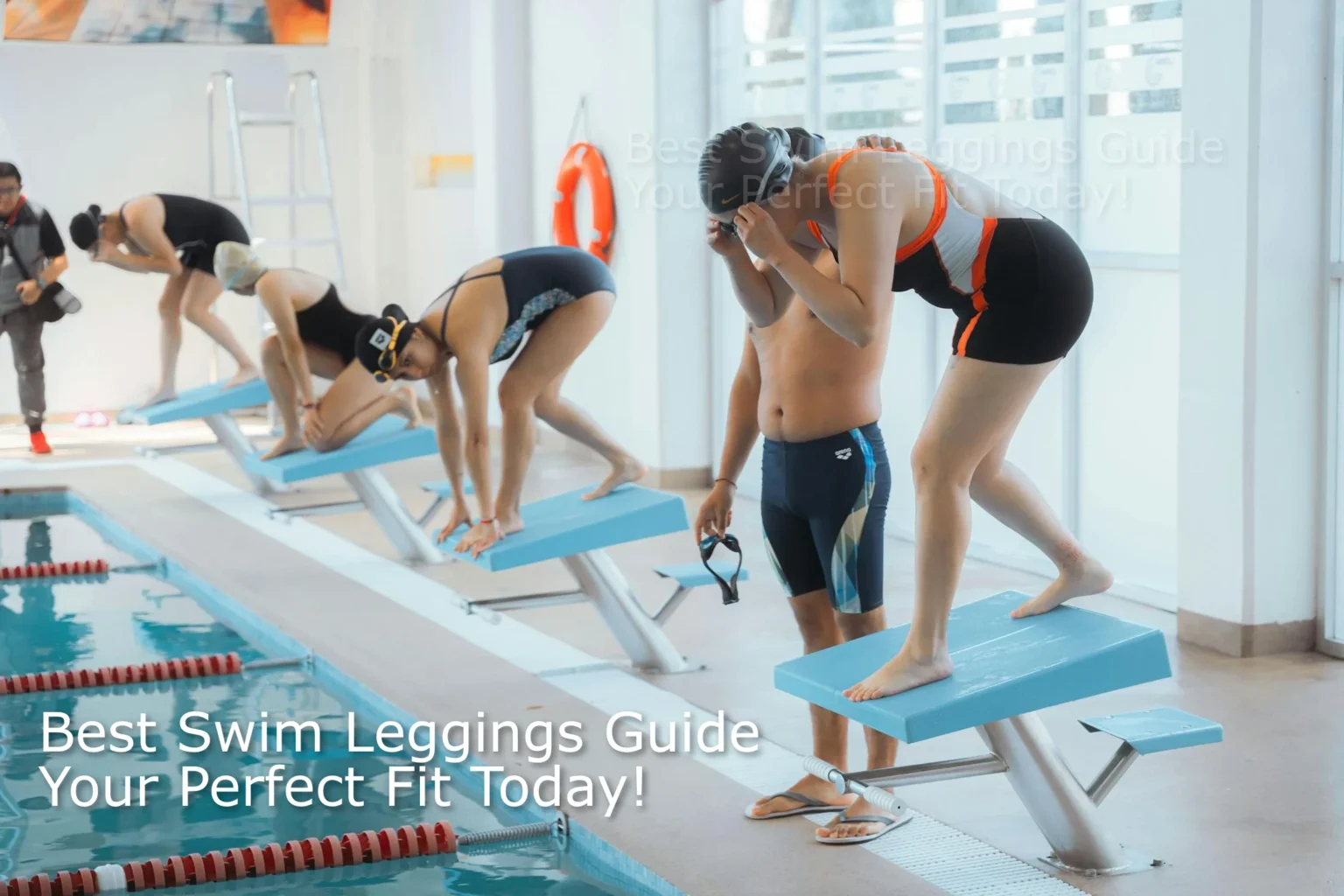Swim leggings are great for water sports like surfing, swimming, or paddleboarding. They protect your skin from the sun, stop rashes, and keep you comfy in the water. This guide helps you pick the right pair by explaining what to look for—like sun protection (UPF), quick-dry fabric, and a good fit. Whether you want more coverage or a bold look, there’s a style for you. Stay stylish, safe, and comfortable with the perfect swim leggings!
What Are Swim Leggings?

Swim leggings are special leggings made from water-friendly fabric. They are designed to be worn in pools, oceans, and other water-based environments. Unlike regular leggings, they dry quickly and provide protection against sun and friction.
Why People Choose Swim Leggings:
- Modesty: Offers full leg coverage.
- Sun protection: Helps avoid sunburns on legs.
- Comfort: Soft and stretchy even in water.
- Versatility: Used for swimming, paddleboarding, and water aerobics.
Common Swim Legging Materials:
| Material | Features |
|---|---|
| Nylon | Lightweight and dries fast |
| Polyester | Durable, UV-protective |
| Spandex/Elastane | Adds stretch and comfort |
How to Find the Best Swimsuit Fit for Swimming
Let’s be honest—most women have walked out of the changing room frustrated and empty-handed after trying on swimsuits that just didn’t work. It’s exhausting, and trying on styles that don’t fit can leave you feeling down about your body.
But here’s the truth: it’s not you. It’s the swimsuit.
We’re here to help you change that and find a suit that actually works for you.
Know What You Like (and Don’t)
The key to finding your perfect swimsuit is understanding what feels right on your body. If you’re shopping for performance swimwear, comfort and functionality are non-negotiable. It needs to hold up in chlorine or saltwater, and then it’s all about design and fit.
To narrow down your options, ask yourself:
- What back style do I prefer?
- How much bust support do I need?
- How much coverage feels comfortable for me—on the back, sides, bum, and chest?
Let’s Talk Backs
Swimsuits come in six main back styles:
- Cross Back
- V or Y Back
- Scoop Back
- Racerback
- Trapeze Back
- Full Back
Some styles have their own variations—like triple cross-backs or extra-deep scoops. You’ll also find different strap thicknesses and some with adjustable straps.
Which Back Style is Right for You?
- Need extra bust support? Go for thicker or adjustable straps. A racerback or V-back with a wider strap across the lower back is a great option.
- Prefer full coverage? A full back, racerback, or a scoop back with a shallow cut will give you more coverage.
- Want to show off a bit? Choose a deep scoop back or cross-back, go bold with side cutouts, higher leg cuts, and cheekier bum fits.
Coverage is Personal
When it comes to coverage, it’s all about what makes you feel comfortable. Whether you want a suit that covers more or one that shows a little extra skin—it’s your call.
Think about:
- Side coverage – more cutouts mean more skin.
- Bum cuts – do you like full coverage or a cheekier fit? Use bum cut icons to compare styles from modest to ultra cheeky.
- Leg height – higher leg cuts make your legs look longer and reveal more skin. Lower cuts offer more coverage and a classic look.
Getting the Right Size
Sizing can be tricky—every brand fits a little differently. The best way to get it right is to take your measurements (bust, hips, and torso length) and use them as a guide. If you have a longer or shorter torso, factor that in too.
Need help?
Use the Trufit sizing tool or check out the Face the Water size guide and chart to compare across different brands and styles.
Performance Swimsuits: Fit Tips
Performance swimsuits should feel snug—almost tight at first. If you see wrinkles, it’s probably too big. Keep in mind that swimsuits loosen over time, especially after repeated use in water.
Since performance suits are designed to last, it’s worth taking a little extra time to find the one that really fits you right.
Features to Look for in Swim Leggings

When buying swim leggings, not all are made the same. Knowing what to look for helps you make a smarter choice.
1. Fabric Quality Look for chlorine-resistant and UPF-rated fabric. High-quality materials last longer and hold their shape better in water.
2. Fit and Stretch A good pair should hug your body without being too tight. Four-way stretch fabric allows better movement.
3. Waistband Style Choose a style that feels comfortable. Some prefer high-waisted for better coverage; others like mid-rise for a looser feel.
Waistband Comparison Table:
| Waistband Type | Benefits |
| High-rise | Better tummy control, stays in place |
| Mid-rise | Offers more comfort for some activities |
| Fold-over | Adjustable, relaxed feel |
4. Seam Construction Flatlock seams reduce irritation and avoid chafing during long swims.
5. Pockets While not always available, some swim leggings come with small pockets for keys or cards.
Best Swim Leggings for Different Needs
For Modest Swimmers:
- Look for full-length coverage and loose fit around ankles.
- Brands that offer UPF 50+ rated fabric are a plus.
Top Picks:
| Brand | Features |
| Coolibar | UPF 50+, ankle coverage, chlorine-resistant |
| Nike Modest | High-rise, breathable, suitable for Islamic swimwear |
For Active Water Sports:
- Needs better grip and tighter fit to avoid slipping.
- Consider leggings with compression and quick-dry features.
Top Picks:
| Brand | Features |
| Speedo | Muscle support, quick dry, high elasticity |
| Roxy | Surf-appropriate, flexible material, snug fit |
For Kids:
- Go for fun prints, soft waistbands, and easy to pull on/off.
Top Picks:
| Brand | Features |
| Splash About | Bright designs, good coverage |
| SwimZip | UV protection, designed for toddlers and kids |
How to Choose the Right Size
Getting the size right is important to avoid sagging or tightness.
Tips for Choosing Size:
- Check the brand’s specific size chart.
- Measure waist, hips, and inseam.
- If between sizes, consider the activity—go smaller for sports, bigger for casual swim.
Measurement Table Example:
| Measurement | Small | Medium | Large |
| Waist (inches) | 26–28 | 29–31 | 32–34 |
| Hips (inches) | 36–38 | 39–41 | 42–44 |
| Inseam (inches) | 26 | 27 | 28 |
Tips for Caring for Swim Leggings

To make them last, proper care is important.
Washing Tips:
- Rinse with clean water after swimming.
- Hand wash with mild soap.
- Avoid machine drying to keep elasticity.
Storage Tips:
- Don’t keep them wet in a bag.
- Hang dry in a shaded area.
- Avoid direct sunlight for long periods.
What Experts Say About Swim Leggings
To make this more helpful, we asked fitness and swimwear experts their opinions.
Expert Insight #1: “The right swim leggings not only protect your skin but improve performance in water aerobics.” — Jenna Lee, Swim Fitness Trainer
Expert Insight #2: “I always recommend high-waisted swim leggings to my clients for extra coverage and a confident look.” — Alina Moore, Modest Fashion Consultant
When to Replace Your Swim Leggings
Like shoes, swim leggings wear out.
Signs You Need New Ones:
- Fabric feels loose or thinned out
- Fading color or chlorine smell that doesn’t go away
- Seams are coming undone
Budget vs. Premium Swim Leggings
Some cost $20, others over $100. What’s the difference?
| Price Range | Features |
| $20–$40 | Basic protection, few design options |
| $41–$80 | Better fit, more patterns, UV protection |
| $81+ | Premium fabric, compression, designer brands |
Should You Spend More? If you swim regularly or want long-lasting gear, investing in premium leggings pays off.
Matching Swim Leggings With Swim Tops
Style and function matter. Here’s how to mix and match.
Pairing Ideas:
- Solid black leggings with patterned rash guards
- Bright colored leggings with solid swim tops
- Full-body swimwear sets for modest needs
Matching Tips Table:
| Legging Style | Suggested Top |
| Bold Prints | Plain rash guard |
| Black or navy | Any color or pattern |
| High-waisted | Cropped or tucked-in tops |
What Are Surf Leggings and Why You’ll Love Wearing Them

Leggings aren’t a new concept. We’ve worn them for yoga, gym sessions, and lounging around at home. But wearing surf leggings for water sports—especially surfing—is a relatively fresh trend. And it’s one that’s catching on fast.
What Are Surf Leggings?
Surf leggings look a lot like your regular gym or yoga leggings, but the key difference lies in what they’re made for—and made of. These leggings are specially designed for water activities like surfing, swimming, paddleboarding, and kayaking. They’re built to handle sun, salt, waves, and wipeouts.
Why You Should Try Surf Leggings
1. They’re Flexible and Stylish
Surf leggings are as flexible as your favorite workout tights but made to perform in the water. They look great on the beach, in the waves, and even off the shore. Heading to yoga before a surf session? These leggings can handle both.
2. Built-In Sun Protection
Unlike typical workout leggings, surf leggings often come with UPF protection—usually UPF 50+, which blocks about 98% of harmful UV rays. That means less worry about constant sunscreen reapplication. Just wear and go.
3. Prevents Rashes and Surfboard Friction
If you’ve ever had your legs rub against your board too much, you know how painful rashes can be. Surf leggings act like a second skin, protecting you from friction, reef scrapes, and rough wipeouts.
4. Warmth and Comfort in Cold Water
Some surf leggings are made from materials similar to wetsuits—quick-drying, breathable, and heat-retaining. This helps you stay warm during cold-water sessions without sacrificing flexibility.
5. Stand Out on the Shore
Tired of the usual black wetsuits and board shorts? Surf leggings come in bold colors, cool prints, and flattering fits that let you express your style while staying functional in the water.
6. No Wardrobe Malfunctions
For women especially, surf leggings offer peace of mind. You don’t have to worry about bikini slips during intense surfing moves. Their snug, form-fitting design keeps everything in place—so you can focus on riding the waves, not fixing your outfit.
What to Look for When Buying Surf Leggings
UPF Rating
Always check for UPF 50+. It’s your best line of defense against UV rays when you’re spending long hours under the sun.
Quick-Dry Material
Avoid cotton—it absorbs water and dries slowly. Look for materials like nylon, spandex, polyester, or neoprene blends that dry quickly and feel light when wet.
Flat-Lock Stitching
If you’ve ever ended a surf session with rashes, poor stitching might be the reason. Opt for flat-lock seams to avoid irritation and chafing.
Quality Fabric Blends
Most high-quality surf leggings use a mix of spandex, neoprene, polyester, and nylon. Each blend brings something special—stretch, support, durability, or comfort.
Top Picks: Best Surf Leggings
Platinum Sun Men’s Compression Swim Leggings
- UPF 50+ protection
- Moderate compression boosts muscle support
- Flat-lock seams to avoid chafing
- Quick-dry and breathable fabric
Coolibar Men’s Deep-Water Swim Tights
- Four-way stretch
- Drawcord waist for a secure fit
- UPF 50+ with chlorine and saltwater-resistant fabric
- Lightweight and fast-drying
Ubestyle Men’s Active Surfing Leggings
- UPF 50+
- Made from 82% Nylon and 18% Spandex
- Stretchy and supportive fit
- Quick-drying with lasting durability
AXESEA Women’s High-Waist Aurora Swim Tights
- UPF 50+
- High-rise design with tummy control
- Slimming vertical lines
- Great for the beach, gym, or yoga
Coolibar Women’s Deep-Water Swim Capris
Chlorine and saltwater resistant
UPF 50+
Four-way stretch
Flat-lock stitching
Mid-rise, mid-calf length (20.5” inseam)
Find Your Perfect Fit And 100% You Will Look Sexy

True-to-size swimwear starts with getting your measurements right. Here’s how to do it:
Bust
Measure around the fullest part of your bust, keeping the tape under your arms and level across your back.
Band
Wrap the tape snugly around your ribcage, just beneath your bust.
This is your band size. For example: 38 inches.
If you wear underwire bras, your regular bra band size is a great reference.
Waist
Bend to one side to find your natural waist crease. Then, stand straight and measure around that point.
Low Hip
Stand with your feet together and measure around the fullest part of your hips and bottom.
Torso
Start at one shoulder and bring the measuring tape down the front of your body, between your legs, and up your back to meet the starting point. This gives you your torso length.
Final Thought
Finding the best swim leggings doesn’t have to be hard. Start by understanding your activity, size, and comfort needs. With the right knowledge, you can choose a pair that looks good, feels great, and lasts longer.
From modesty to sporty use, swim leggings are a smart and stylish choice for many people. If you treat them well and pick wisely, they’ll serve you for seasons to come.





